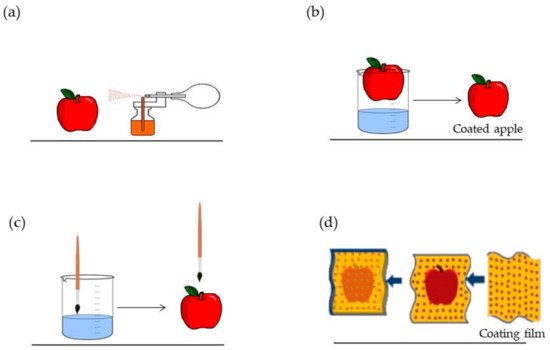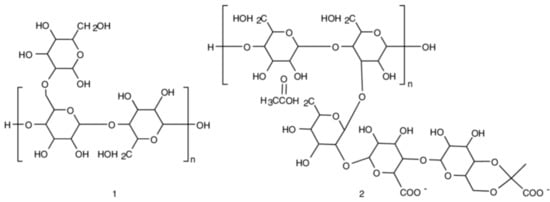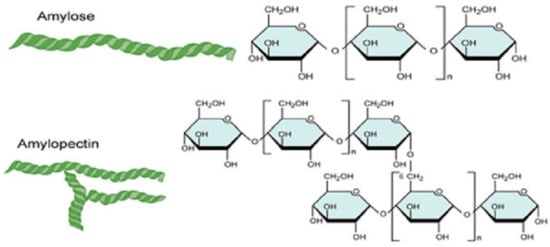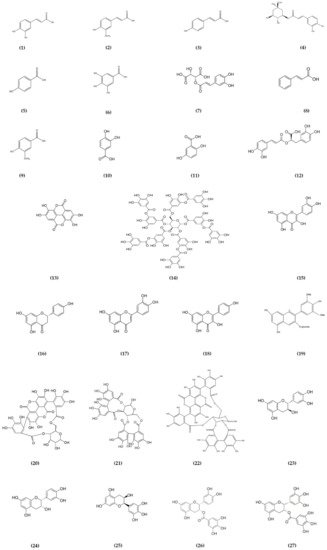Edible films and coatings allow preserving fresh and processed food, maintaining quality, preventing microbial contamination and/or oxidation reactions and increasing the shelf life of food products. The structural matrix of edible films and coatings is mainly constituted by proteins, lipids or polysaccharides. However, it is possible to increase the bioactive potential of these polymeric matrices by adding phenolic compounds obtained from plant extracts. Phenolic compounds are known to possess several biological properties such as antioxidant and antimicrobial properties. Incorporating phenolic compounds enriched plant extracts in edible films and coatings contribute to preventing food spoilage/deterioration and the extension of shelf life.
- edible coatings and films
- phenolic compounds
- starches
1. Introduction
Biopolymers are organic polymers and according with its origin are classified, mainly, into three types: biomass-derived polymers (e.g., proteins and polysaccharides including chitosan, starch and cellulose); synthetic polymers derived from oil or biomass monomers such as polylactic acid (PLA), polycaprolactones (PCL) and polyvinyl alcohol (PVA); polymers produced by natural microorganisms or genetically modified (e.g., polyhydroxyalcanoates and bacterial cellulose) [1][2][3][4][5][1,6,8,9,10]. In general, bioplastics present some advantages relative to common plastics: namely, they use less energy and are biodegradable, safe and emit less greenhouse gases; provide longer shelf life and are suitable for the production of compost; the chemical structure is more diversified, making possible the customization of the properties of the final package according to the type of food; and possibility of nanoparticles incorporation and adding or improving important properties such as thermic stability, gas impermeability/barrier including to oxygen, antimicrobial properties and strength [6][4][4,9]. Regardless of these advantages, bioplastics have some issues concerning its mechanical and barriers properties, which require the addition of additives or other synthetic polymers (e.g., via hydroxypropylation) improving the referred properties [1][7][1,7]. Therefore, biopolymers may not be 100% made of renewable sources as some are blends of natural polymers with synthetic polymers or incorporate additives that improve the functional properties of the final package [1].
Biopolymers are used to prepare edible films and coatings, materials with thickness below 0.3 mm that are produced through a blend of biopolymers with different additives dispersed in an aqueous phase, and are safe to eat [8][9][10][5,11,12]. Edible films and coatings are easily manufactured, economically viable [11][13] and provide mechanical protection and improvement of food quality through moisture regulation and internal equilibrium between gases and solutes [8][10][11][5,12,13]. In addition to that, these materials can protect against UV radiation, fungi and bacterial contamination [8][5]. Edible films and coatings have the capacity to carry bioactive compounds, such as phenolic compounds, vitamins, nutraceuticals and probiotics, which improve food quality and, at the same time, provide additional health properties to the consumer after food consumption [8][12][5,14]. All these characteristics contribute to shelf-life increase [8][10][5,12] and a reduction in the use of additives [13][15]. In general, edible films and coatings are classified into the following: oil/water emulsions and colloidal dispersions [8][5]. They can be applied by dipping, spreading, spraying and wrapping (Figure 1) [8][10][11][5,12,13]. They can also be classified according to the type of application: edible coatings applied by dipping, spreading or spraying and edible films produced by compression molding, solvent casting or extrusion and that are used to wrap food [8][10][5,12].

2. Gums Used in Food Packaging

| Polysaccharide | Food Application | Bioactive Compounds Incorporated | Type of Packaging | Application Coating Method | Results | References | |||||
|---|---|---|---|---|---|---|---|---|---|---|---|
| Xanthan | Melon | β-carotene nanoparticles | Coating | Immersion | Improvement of coatings properties and increase in shelf time to 21 days at 4 °C | [25][26] | |||||
| Refrigerated fish | Chitosan | Film | - | Inhibition of the growth of Staphylococcus coagulase-positive, Salmonella spp. and coliforms at 45 °C Quality preservation |
[27] | ||||||
| Acerola | - | Coating | - | Reduction of weight loss and the respiration process Increase in shelf life (prolongation of 6 days at 30 °C without deterioration signs |
[5] | ||||||
| Pear | - | Coating | - | Retained the weight during 9 days of storage Prevention of oxidation |
[28] | ||||||
| Baby carrots | α-tocopherol | Coating | Dipping | Edible coatings improve the surface colour without organoleptic properties alterations | [ | ||||||
| Potato | “Orri” mandarins | Glycerol | Coating | Immersion29] | |||||||
| Weight loss reduction | [ | 65 | ] | Galactomannan | Ricotta cheese | Nisin | Coating | Dipping | Delay of microbial growth during 28 days Weight loss and moisture content decreasing |
[30][31] | |
| Tapioca | Cauliflower | Gelatin | Coating | Dipping | Weight loss reduction Total soluble solids increase |
[66] | Guar gum | Fruits | Nisin | - | |
| Cassava | Blackberries | Chitosan - |
Decrease in gas transfer rates | Glycerol[31 | Coating | Immersion | Good sensorial properties (colour maintenance) Weight loss reduction and firmness increase during 10 days of storage] |
[67][32][33] | |||
| - | Ag/Cu nanoparticles | Film | Spreading | Strong antibacterial activity against Gram-positive Listeria monocytogenes bacteria and Gram-negative Salmonella enterica sv typhimurium Excellent UV, light and oxygen barrier capability |
- | ||||||
| Banana “Pear” | Mango | Pectin | Coating | - | High firmness High total soluble solids Post harvested period extended to 21 days Retention of colour mango fruits |
[68] | Roma tomato | - | Coating | Immersion | |
| Wheat | Plums | -Firmness enhancement Reduce the weight loss Retarded loss of total acidity Respiration rate decrease |
[33] | ||||||||
| Coating | Immersion | No colour changes Improvement of water vapour and oxygen permeability |
[69] | Blackberries | - | - | - | Shelf-life extension for 13 days | [34] | ||
| Chickpea | Papaya | Glycerol Stearic acid |
Film | Dipping | Reduced weight loss, better firmness and colour retention at 10 °C during 10 days of storage | [70] | lemon | Spice extracts | Coating | Dipping | Shelf-life extension Maintenance of quality during cold storage |
| Cassava | Black mulberry | Inhibition of bacterial growth | [35] | ||||||||
| Chitosan | Coating | Immersion | Minimized weight loss and mold decay during cold storage (5 °C) for 16 days No alterations at firmness, colour and anthocyanin content |
[71] | Litchi fruits | - | Coating | - | Maintenance of fruit quality Shelf-life extension up to 10 days under low temperature storage |
[36 | |
| Tomato | Vegetable oil, glycerol, soy lecithin and cellulose and derivates | ] | |||||||||
| Film | Immersion | Delay changes in firmness, weight, titratable acidity, pH, total soluble solids, sugar/acidity ratio and colour development Increased shelf life of tomatoes stored at 20 ± 2 °C up to 1 month |
[72] | Red chilli pepper | - | Coating | Dipping | Maintenance of fruit quality without deterioration during 20 days at storage temperature of 6 °C | [37] | ||
| Arabic gum | Tomato | ||||||||||
| Toasted groundnuts |
Soy protein concentrate | Coating | Dipping | Excellent sensorial properties Shelf-life extension during 14 days at ambient temperature |
[73] | - | Coating | Immersion | Delay of the ripening process Shelf-life extension for 20 days without deterioration and off-flavours, stored at 20 °C |
[38] | |
| Pineapple | Alginate Ascorbic acid Glycerol |
Coating | Immersion | Lower levels of reducing and total sugars Better appearance and general acceptance during room storage for 18 days Preservation of sweetness, taste and odour and better appearance |
[74] | Guava | Sodium caseinate and Tulsi extract | Coating | Dipping | Maintenance of suitable internal gas composition delaying ripening Shelf-life of 7 days at 28 ± 2 °C compared to 4 days of control |
[39] |
| Green chillies | Glycerol Thyme oil Tween 80 |
Coating | Dipping | Preservation of the quality and organoleptic properties During 12 days |
[40] | ||||||
| Persimmon fruits | - | Coating | Dipping | Lower weight loss, membrane leakage, H2O2 and malondialdehyde content relative to the control Suppression of the increase in activities of polygalacturonase, pectin methylesterase and cellulase enzymes Higher superoxide dismutase, peroxidase, ascorbate peroxidase and catalase activities |
[41] | ||||||
| Mangoes | - | Coating | Dipping | Gas and water vapour barrier properties Slower the ripening process Shelf-life extension for 15 days relative to less of 10 days in control |
[42] | ||||||
| Gum tragacanth | Button mushroom | Aloe vera leaves extract | Coating | Immersion | Slow the loss of weight and colour changes under cold storage | [43] | |||||
| Fresh apricots | Chitosan | Coating | Dipping | Improvement of firmness and stability in terms of weight loss, pH and moisture content during storage | [44] | ||||||
| - | Coating | Dipping | Good sensorial qualities Antioxidant properties Maintenance of ascorbate peroxidase (APX), catalase (CAT), superoxide dismutase (SOD) and peroxidase (POD) enzymes activities Inhibition of polygalacturonase (PG), pectin methylesterase (PME) and cellulase (CX) enzymes activities |
[45] | |||||||
| Locust bean | Fortune mandarins | - | Coating | Immersion | Weight loss delay Improve gloss of the fruits |
[46] | |||||
| Konjac glucomanann | Fresh-cut cucumber | Saffron petal extract | Film | - | Reduction in the water vapour permeability Antimicrobial properties against Escherichia coli (E. coli), Shigella sonnei, Salmonella Typhi, Staphylococcus aureus (S. aureus) and Bacillus cereus Preservation of fruits and vegetables quality Shelf-life extension |
[47] | |||||
| Guava | - | Coating | Immersion | Maintenance of firmness and colour Reduce weight loss |
[48] | ||||||
| Cantaloupe | Potassium sorbate | Coating | - | Maintenance of weight loss, hardness and firmness Inhibition of microbial growth Preservation of sliced cantaloupe up to 5 days |
[49] | ||||||
| Gellan gum | Mango | - | Coating | Dipping | Improvement of sensorial characteristics namely appearance and firmness Stabilization of colour and volatiles composition during storage |
[50] | |||||
| Almond gum/Persian gum | Tomato | - | Coating | Immersion | Delay changes in colour, weight loss, firmness, acidity, ascorbic acid content, soluble solids concentration and decay percentage during a storage period of 20 days. | [51] | |||||
| Cherries | Gum Arabic | Coating | Immersion | Delay the ripening process and increase the shelf life of cherries without spoilage or off-flavour | [52][53] |
3. Starches Used in Food Packaging
Starch is produced by plants, some strains of fungi and algae and is used for energy storage [54][63]. It comprises amylose and amylopectin polymers (Figure 3) [7][55][56][7,64,65] made up of α-D-glucose monomers [7][55][7,64].
| Starch Source | Food Application | Bioactive Compounds | Type of Packaging | Application Coating Method | Results | References |
|---|---|---|---|---|---|---|
| Tropical fruits: banana “Pear”, soursop, stenospermocarpic mango | Stenospermocarpic mangoes | - | Coating | Immersion | Mango starch showed better results than the other starches coatings tested: less weight loss, greater firmness, high content of total soluble solid and shelf-life extension up to 15 days (10 days at 10 °C and 5 days at 22 °C) | [61] |
| Corn | Banana | Gum Arabic Glycerol Sorbitol |
Film | Dipping | At a temperature of 26 °C, the coated fruits lose less weight than control (uncoated fruits), retaining firmness and delaying the ripening process | [62] |
| Cassava | Mango | Chitosan | Coating | Immersion | At 25 °C, the coating showed good sensorial qualities and decreased respiration rate without prejudicing the ripening process Shelf-life extension up to 3 days |
[63] |
| Rice and cassava | Pummelo | Pummelo juice | Film | Immersion | Lower weight loss Physical appearance stabilization |
[64] |
| Guavas | ||||||
| Gelatin | ||||||
| Chitosan | Film | Immersion | Decrease weight loss Shelf life increased up to 9 days relative to non-coated guavas Slowed the ripening process (after 27 days of storage, the fruits had not reached senescence) |
[75] | ||
| Waxy corn | Rice cakes | Gellan gum | Film | Dipping | Preservation of texture of rice cakes during 24 h of storage Reduction in moisture loss and delay of hardening |
[76] |
| Potato | Grape | Rice bran oil | Coating | - | Good water vapour barrier Preservation of the grape’s quality Long-term shelf-life extension |
[77] |
| Corn | Apples | Papaya polysaccharides | Film | - | Increase in swelling and tensile strength, reduction in thickness, transparency and solubility Improved sensorial acceptance |
[78] |
4. Methods of Incorporation Phenolic Compounds in Gums and Starch-Based Coatings and Films
The incorporation of phenolic compounds must consider final packaging characteristics, the bioactive substances used and their application in foods. To produce active films, the incorporation of bioactive compounds can be made by mixing them directly with films production or by encapsulation resulting in nanoparticles formation [79][88]. The usual methods for starch films production are by casting, pressing and extrusion [79][88]. The solvent casting method is the most used for the incorporation of phenolic compounds in polysaccharide films or coatings [80][89]. With respect to the formation of film, the polymeric solution is spread on the intended surface and posteriorly air dried in a ventilated oven. After solvent evaporation, the film is removed from the surface maintaining the surface form. However, the removal of film surface can cause it to wrinkle and tear. The physico-chemical properties of films depend on the composition of casting solution, wet casting thickness, temperature and relative humidity conditions [80][89]. The extrusion method is based on the thermoplastic properties of biopolymers. The biopolymer solution contains a plasticizer that is heated above its glass transition temperature under reduced water conditions. Posteriorly, the films are submitted to compression, casting and extrusion, resulting in the formation of more elastic films [80][89]. The applications of coatings, thickness and their ability to adhere to food surface are important characteristics for food quality preservation. Therefore, coatings can be applied by spraying, dipping and spreading [80][89]. Active starch and gum-based films and coatings were prepared mainly by casting method. Glycerol was the most used plasticizer in the preparation of active coating and films [81][82][83][84][85][90,91,92,93,94]. In general, the percentage of bioactive compound or extract in starch and gum-based coatings is low, ranging between 0.03 and 1.20%, and all the extracts and isolated bioactive compounds tested acted at the level of lipidic oxidation and microbiological contamination, preventing food spoilage and increasing its shelf-life.5. Phenolic Compounds Incorporated in Gums and Starches for Preparing Active Films
Antimicrobial activity of polyphenolic compounds is generally related with the induction of the leakage of cellular content; blocking DNA/RNA/protein synthesis; and, consequently, their function; modifications on membrane potential; disruption of membrane structure and function and induction of cytoplasmatic acidification; and coagulation of cytoplasmatic constituents [86][112]. On the other hand, most polyphenols present antioxidant properties as they can act against oxidative species such as Reactive Oxygen Species (ROS) through radical scavenging and also prevent ROS generation by iron chelation, presenting antioxidant properties [87][113]. In addition to its biological properties, many polyphenols have the capacity to enhance physico-chemical properties of the film or coating packages such as enhancement of its water/vapour barriers, tensile strength, colour, solubility and organoleptic characteristics [88][100]. Essential oils also have antimicrobial activity against bacteria and fungi. When added to films or coatings, due to its volatile compounds content, essential oils can also modify the organoleptic characteristics of foods (e.g., unpleasant odour and flavour). However, comparatively to plant extracts, the production of essential oil has lower yields and, consequently, less economic value. Thus, essential oils applications in food packaging are limited [86][112]. There are several studies concerning the incorporation of polyphenols in films containing polysaccharides. Cassava starch films with green tea and aqueous palm oil extracts were developed and applied in butter. The active edible starch films presented antioxidant activity decreasing the peroxide index, but in high concentrations of green tea extract polyphenols can act as pro-oxidants. Moreover, green tea and palm oil extracts reduced tensile strength and water vapour barriers [81][90]. Mango peel powder, a by-product, was added to starch edible films and applied on apple slices storage at a temperature of 4 °C. The phenolic compounds present in mango peel powder were responsible for higher antioxidant activity. The mango peel extract also increased the resistance of edible films, maintaining the film structure as almost intact [89][114]. In order to preserve acidic foods and drinks (e.g., wine and juices), chitosan/genipin active edible films were developed. The authors fractionated the wine extract in three fractions and produced three active edible chitosan films: chitosan films with phenolic compounds mixture (PCM), chitosan films with anthocyanins (AN) and chitosan edible films with phenolic acids (PA). The qualitative analysis of phenolic acids fraction showed the presence of gallic ((6), Figure 45), p-coumaric ((3), Figure 45), trans-caftaric ((7), Figure 45), p-hydroxybenzoic ((5), Figure 45), caffeic ((1), Figure 45) and chlorogenic acids ((4), Figure 45), (+)-catechin ((23), Figure 45) and (−)-epicatechin ((24), Figure 45). The anthocyanins fraction was mainly comprised malvidin-3-glucoside ((19), Figure 45). PCM and AN active edible chitosan/genipin films showed lower solubility and, therefore, lower weight loss. Concerning antioxidant activity, PA chitosan films were the most active followed by anthocyanins and phenolic compounds mixture. Thus, this active chitosan film has potential as an acidic food preservative [90][115].
